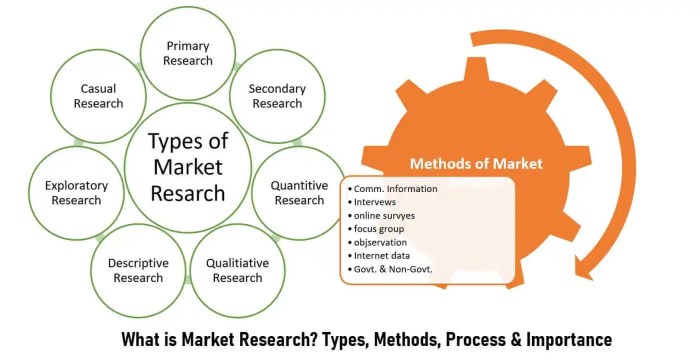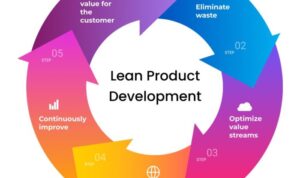Market Research Techniques, essential for business success, encompass a blend of traditional and digital methods that shape industries. Dive into the world of qualitative and quantitative research to discover the secrets of effective decision-making.
From focus groups to big data analytics, explore the tools and techniques that drive market research forward in the digital age.
Market Research Techniques Overview
Market research is like the secret sauce for businesses – it helps them understand their customers, competitors, and the overall market landscape. With this info, companies can make smart decisions and create killer strategies to stay ahead of the game.
Traditional market research methods used to involve surveys, focus groups, and interviews. But now, with the rise of technology, digital techniques like social media monitoring, data analytics, and online surveys have taken over. These modern methods provide quicker results and deeper insights into consumer behavior.
In industries like fashion, tech, and food & beverage, market research techniques are crucial for success. Fashion brands need to know the latest trends, tech companies must keep up with ever-changing tech preferences, and food & beverage businesses must understand consumer tastes to create products that sell like hotcakes.
Examples of Industries
- Fashion: Keeping up with the latest trends and consumer preferences is key for fashion brands to stay relevant and profitable.
- Tech: Understanding the needs and preferences of tech-savvy consumers helps tech companies develop products that meet market demands.
- Food & Beverage: Market research helps food & beverage businesses create products that cater to consumer tastes and preferences, leading to increased sales and brand loyalty.
Qualitative Market Research

Qualitative market research involves gathering non-numerical data to understand consumer behavior, preferences, and motivations. The main objective is to delve deeper into the why behind consumer actions rather than just the what.
Common Methods
- Focus Groups: Small groups of individuals discuss a product or service, providing valuable insights into their perceptions and feelings.
- Interviews: One-on-one conversations with consumers allow for in-depth exploration of their thoughts and experiences.
- Observations: Researchers observe consumer behavior in real-life settings to gain a better understanding of their actions.
Case Study
A popular cosmetics company conducted qualitative research to understand why their new skincare product was not selling as expected. Through focus groups and interviews, they discovered that consumers were confused by the packaging and unsure of the product’s benefits. Based on this feedback, the company redesigned the packaging and launched a new marketing campaign highlighting the product’s key features. Sales increased significantly as a result of these changes, demonstrating the impact of qualitative research on business decisions.
Quantitative Market Research: Market Research Techniques

Quantitative data plays a crucial role in market research by providing measurable and numerical information that helps in making informed decisions. It involves gathering data in the form of numbers and statistics to analyze trends, patterns, and relationships within a target market.
Quantitative Techniques
- Surveys: Surveys are a common quantitative research method used to collect data from a large sample size. They involve structured questionnaires with closed-ended questions that can be easily quantified and analyzed.
- Experiments: Experiments allow researchers to manipulate variables and measure the impact on consumer behavior or preferences. This controlled environment helps in drawing causal relationships between factors.
- Statistical Analysis: Statistical analysis involves using mathematical models to analyze data and draw conclusions. It helps in identifying correlations, trends, and significant findings within the data.
Role of Big Data
Big data plays a significant role in quantitative market research by handling large volumes of data quickly and efficiently. It allows researchers to analyze massive datasets to uncover patterns and insights that traditional methods may miss. Big data analytics can help in predicting consumer behavior, identifying market trends, and making data-driven decisions.
Online Market Research Techniques
In today’s digital age, online market research techniques have become increasingly popular due to their convenience and effectiveness in gathering valuable insights. Conducting market research online offers several advantages, utilizes various tools and platforms, and requires careful attention to ensure the accuracy and reliability of the data collected.
Advantages of Online Market Research, Market Research Techniques
- Wider reach: Online research allows access to a larger and more diverse pool of respondents compared to traditional methods.
- Cost-effective: Conducting research online is often more affordable than traditional methods, saving on expenses such as printing and postage.
- Real-time data collection: Online surveys and polls provide instant feedback, allowing for quick analysis and decision-making.
Tools and Platforms for Online Market Research
- Online survey platforms: Platforms like SurveyMonkey, Google Forms, and Qualtrics enable researchers to create and distribute surveys easily.
- Social media analytics: Tools like Facebook Insights, Twitter Analytics, and Google Analytics help track consumer behavior and trends online.
- Online focus groups: Platforms such as Zoom, Skype, and Microsoft Teams facilitate virtual focus group discussions for in-depth insights.
Ensuring Accuracy and Reliability of Online Research Data
- Use multiple sources: Cross-reference data from different online channels to validate findings and ensure consistency.
- Ensure respondent authenticity: Implement verification measures to confirm the identity and reliability of survey participants.
- Consider sample size and demographics: Ensure the sample size is sufficient and representative of the target population to avoid biases in the data.





